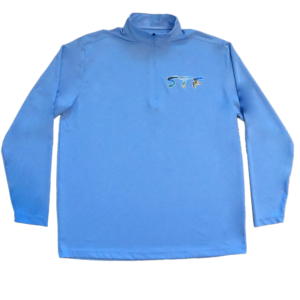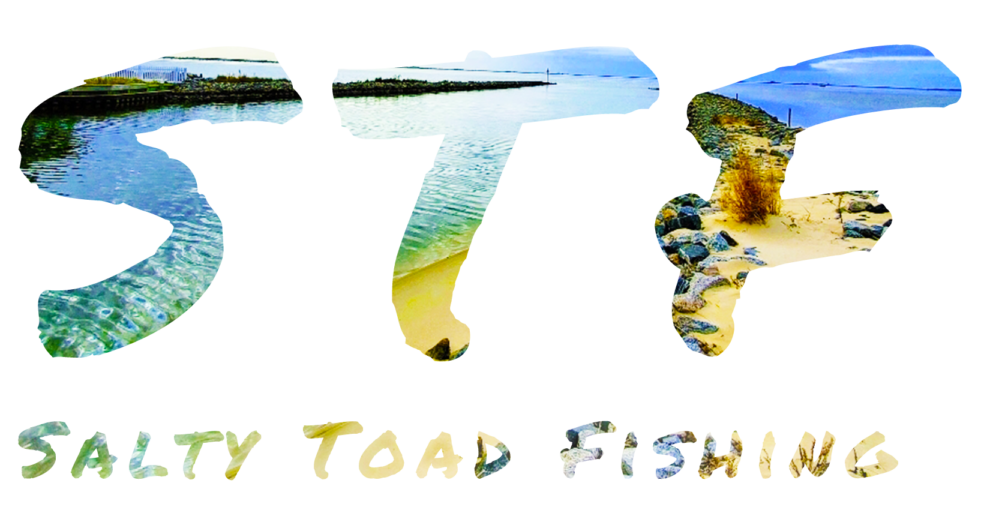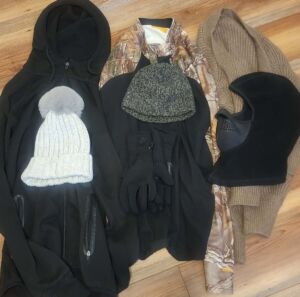Clothing:
Many people are unsure what to wear when planning a day of fishing. With my experiences fishing in below 0 temperatures in New York, as well as fishing in temperatures in triple digits here in North Carolina, I will be giving my input and advice on what has worked best for me throughout the years. Below I will breakdown the different types of clothing and protective wear to keep you comfortable in any conditions on the water.
Headwear:
Whether it be in the middle of the summer, or a cold winter day, it is important to keep your head, neck, and facial area protected.
In the summer, there are a few options that I prefer to keep my head cool and protected from the sun. The most basic option, a ball cap, is most people’s “go-to”. A ball cap works pretty well for shading your eyes and is among the top as far as comfortability goes, however it is not the most protective by itself. I believe it would be wise for anyone who prefers to wear a ball cap to pair it with a gaiter of some sort to keep your neck and facial region protected. Gaiters can be ideal in many conditions when fishing because they give you the ability to cover most of your face and sensitive areas above your shoulders, while allowing you to stay cool and comfortable as well. A ball cap and a gaiter are my go-to when heading out on the water during warm summer days. Another solid headwear option for the summer would be a bucket hat. These hats have an extended brim all the way around them to break up some of those sun rays and keep your face protected. Again, they don’t fully protect you, but when paired with a gaiter or some sunscreen they also act as a comfortable, cool, option.
In the winter, keeping your skin protected is just as important, if not more important, than in the summer. Making sure your face is protected is absolutely essential when fishing in cold winter conditions. While living in New York, ice fishing was a hobby of mine. Being out on the ice in sub-zero temperatures allowed me to experience what worked the best for staying warm. Making sure you have a thick, warm hat to keep your head warm is arguably the most important factor when fishing in these freezing conditions. Most people believe that you lose 70% of your body heat through your head. That is actually a myth, however it is still crucial that your head stays protected throughout the day. Gaiters also work well for winter, as they do for summer fishing. I would cover most of my exposed skin with a gaiter, to prevent the cold wind from reaching my skin directly. Having your skin exposed to these freezing winds leaves you most vulnerable to frostbite, so staying covered should be one of the top concerns for individuals in these conditions.
You can find our STF Headwear here: Products
Tops:
Wearing improper clothing on the water could lead to misery for a multitude of reasons. Whether it be getting a bad sunburn, or being too cold, I will be providing my advice on the best tops to wear both during the hot summer days, as well as those cold winter days out on the water!

Summer can be some of the best fishing throughout the year. Staying protected against the brutal heat out on the water is absolutely essential, to keep your skin healthy and safe while out there. Applying sunscreen is one of the most effective, consistent ways to keep your skin protected, however, it can be annoying or often forgotten to reapply it every couple hours. I know when I’m out on the water, the last thing I want to do is stop casting so I can go put more sunscreen on! Getting some proper attire would negate having to use sunscreen and allow you to cast freely throughout your trip without any interruptions! When looking for a shirt best fit to protect you, you are going to want to lo
ok for the UPF rating. The UPF is an Ultraviolet Protection Factor. Many shirts come with a UPF rating of 30 or 50. A UPF 50 shirt entails that only 1/50th of the sun rays will be able to penetrate your shirt and reach your skin, a percentage of 2%. Many UPF 30 shirts would suffice just fine, but if you have sensitive skin, or just want that little extra protection I would definitely advise grabbing yourself a UPF 50 shirt.
Winter fishing is great in many states, just a little more uncomfortable at times. One main tip I can give is to prioritize getting some gloves. They make all sorts of variations that allow fishing to still be comfortable, while protecting your hands against the cold temps and freezing winds. Usually, I go with a long sleeve shirt, and a hoodie or jacket depending on how the weather is. When planning a fishing trip in the winter, I always make sure to bring more clothing rather than less. Another extremely important attribute for winter clothing is being waterproof. Staying dry could arguably be the most important factor during these freezing days. Keeping your core body temperature stable could become a serious issue if you become wet
and should be avoided at all costs. Something that plays a factor in keeping you warm is also layering. Believe it or not, certain fabrics are better for layering than others. For example, a wool sweater or shirt would best suit you as your outermost layer and is considered the warmest fabric you can wear. Wool is a great option for keeping warm. Another great option is silk, although most wouldn’t think that. Silk does not act as a great outer layer, however, layering clothes over silk works extremely effectively, and comfortably during these cold days. A fleece jacket, or a flannel is also an effective material for winter, and as always, cotton is never a bad choice. You can always take layers off later on but can’t put it on if you don’t have it. My advice would be to always bring at least 1 more layer than you think you will need.
You can find our STF Tops here : Products
Bottoms:
Likewise with headwear and shirts, wearing proper clothing for your bottom half is also important to making sure your fishing experience is as enjoyable, and comfortable as possible.
There are a few key factors that go into wearing proper pants for fishing during both warm and cold weather. During summer months, it is recommended to wear pants regardless of the warm temperatures. Protecting your legs is just as important as protecting your arms or face from those brutal UV rays on the water. Again, the UPF rating in pants coincides directly with shirts. I would recommend getting pants with a UPF rating of at least 30, but you can choose to get UPF 50 if you would prefer. A lightweight, waterproof pair of pants with a proper UPF rating should result in a comfortable, and protective day of fishing on the water. There are some pants that have zippers to allow you to turn them into shorts. These pants give you versatility, but you would then need to apply sunscreen if you did choose to take the lower half off. It is essential to find a pair of pants that allows you the functionality, and comfortability that will allow you to spend long days on the water with the utmost level of enjoyment. Some of the more common fabrics when looking for these types of pants would either be a cotton fit, or nylon, with some spandex for that flexibility and extended levels of motion. Making sure you have waterproof pants isn’t as important in the summer, but I will touch base regarding that in the winter section below.
An enjoyable day of fishing in the winter is much more reliant on proper bottoms than it is in the summer. Arguably the biggest factor when looking for clothing for the colder months would be waterproof. It is crucial that you stay dry during these temperatures and keep your body safe. Layering is a solid way to stay warm during the winter, however it can lead to being uncomfortable and limiting mobility at times. My suggestion would be to wear a warmer pair of pants underneath, and pair those with some waterproof pants, or a pair of bibs on top. Fleece lined pants are a great option for staying warm for those bottom layers. Bibs also act as a great option for these cold days. Not only do some bibs provide essential warmth protection, but they also come in many waterproof options. These would not only protect your lower half from the elements, but it also serves as protection for your upper core to an extent as well. Overall, in my opinion, staying dry is the most important part about winter fishing. I would highly suggest getting some waterproof pants and layering for warmth underneath.
Footwear:
There’s not a ton to write about footwear, however I will break down some of my experiences and suggestions below.
For summer months, the main goal of footwear is to protect your feet from the sun. I know personally my feet burn very easily, and this results in a miserable day of fishing when that happens. One of the most common forms of footwear worn by anglers would be a simple pair of deck boots. Not only do these boots provide protection from the sun, but many are waterproof and keep your feet and socks dry while out on the water. Most that have fished their whole life know that there is nothing worse than wet feet and wet socks, been there done that. 😒 Deck boots come in a variation of styles, both short and tall depending on your preference. Another option is just a normal pair of sneakers. These will provide plenty of protection against the sun, but most are not waterproof like deck boots. If you really want maximum comfortability you can always wear a pair of sandals, but applying sunscreen would be crucial if this is your choice.
Footwear is much more important when it comes to winter fishing. Again, keeping your feet dry is of utmost importance during these trips. Wearing a pair of waterproof, insulated boots is the most common option when winter fishing. Most winter boots come with a warmer lining inside them, while providing that waterproof shell on the outside. These are a great option for fishing on cold days. Many boots come with a temperature rating. These temperature ratings suggest the lowest possible temperature that your boots would be able to provide warmth in. For example, a pair of boots with a cold rating of “-20” would suggest that those boots can provide warmth to your feet in temperatures as low as 20 below 0. Depending on your preference, you can choose what cold rating you believe would best suit your needs. Another important factor for footwear would be your sock selection. You want something that will provide you warmth, but also allow comfortability while still sustaining mobility. A pair of thick wool socks would be the warmest option available. Pairing these with a pair of warm boots should provide plenty of warmth, and keep you protected out on the water.



